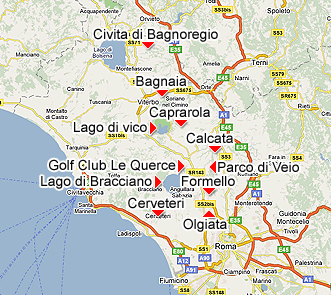Sutri
Sulla collina di tufo è ancora visibile la necropoli etrusca di tipo rupestre, di essa sono oggi visibili 64 tombe disposte su più livelli. Le tombe sono datate dal III secolo aC al I secolo dC. Vivino a queste affascinanti tombe è uno dei più evocativi antichi monumenti del Lazio: l'anfiteatro di Sutri. A pochi metri dall'anfiteatro ci sono alcune tombe etrusche, trasformate in Mitreo nel III secolo dC e che susseguentemente furono usate come chiesa cristiana dedicata alla "Madonna del Parto", al suo interno sono interessanti dipinti rappresentanti San Michele Arcangelo, la leggenda di Gargano e i pellegrini in viaggio verso i luoghi sacri. L'anfiteatro di Sutri: è interamente scavato nella roccia tufacea di una collina con un orientazione nord-sud il suo asse più grande è lungo 49 m. mentre l'asse minore è lungo 40 m. Essendo scavato nella roccia, l'anfiteatro manca dall'esterno di una precisa forma architettonica, nella parte interna sono presenti delle gradinate, corridoi d'accesso e porte d'ingresso. Fu costruito con tecnica etrusca e da lavoratori etruschi tra la fine del I secolo aC e l'inizio del II secolo. Town of ancient origins with rests and monuments of the Etruscan, Roman age and the medieval period, that attest its strategic importance. Sutri had the period of main splendor in the Etruscan time - from IV the century a.C. - when, fortified on the height of tufe (are visible the rests in blocks of tufe), it controlled the commerce in this part of Etruria. From here the denomination of T. Livio of "door of the Etruria". Stormed by the Romans in the 394 a.C. it knew hard battles between Etruscans and Romans in 311 and 310 a.C. Its prosperity grew with the construction of Cassia, a great artery of traffic between Rome and the northern regions. Later on was a roman municipium and with Augusto, was named Colony Coniuncta Iulia Sutrina (Sutrium). I n the hill of tufe is still visible the Etruscan necropolis of rupestre type. Of it are visible today 64 tombs disposed on more levels. The tombs are dated from 3th century a.C. to the 1st century d.C. Near this fascinating tombs is one of most evocative ancient monuments of the Lazio: the amphitheater of Sutri. A few meters from it, are some Etruscan tombs, transformed in Mitreo in the 3th. century d.C. and that subsequently was used as a Christian church dedicated to the "Madonna del Parto", to its inside interesting paintings representing Saint Michael Archangel, the legend of Gargano and pilgrims in travel towards the sacred places. The amphitheater of Sutri: it's entired dug in the tufaceus cliff of the hill with a line North-South and has the greater axis 49 mt. long. and that minor of 40 mt. Lacking to the outside of a precise architectonic shape, in the inner side its present gradinate, corridors of access and entrance doors. It was constructed with Etruscan technique and Etruscan workers between the end of 1st century a.C. and the beginning of the 2nd century. |

